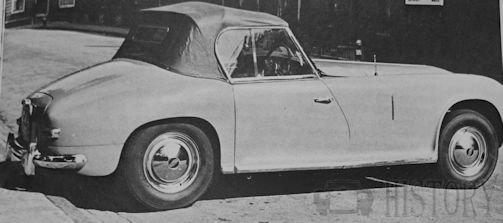Marauder Cars History
 | |
| Manufacturer | Marauder Cars |
|---|---|
| Production | 1950–1952 15 made |
| Body style | 2-door convertible 2-door coupé |
| Engine | Rover 2103 cc straight 6 (A model) 2392 cc (100 model) |
| Transmission | 4-speed manual with optional overdrive |
| Wheelbase | 102 in (2591 mm) |
| Length | 166 in (4216 mm) |
| Curb weight | 2,576 lb (1,168 kg) |
| Designer(s) | George Mackie, Spencer King, Peter Wilks |
The components it used, and the personalities behind it. The Marauder story actually began with the formation of Wilks, Mackie & co. in 1950, though the thinking behind it dates back to the Rover special racing car. This had been designed on a real financial shoestring by Peter Wilks, Spencer King and George Mackie, all of whom worked for Rover. Having succeeded with this car, the three decided to set up their own company.
King opted to stay with the Rover concern (he is now Deputy Chairman of B.L. Technology), while Wilks and Mackie left to design the new car. As they all had had a great deal of involvement with the birth of the new P4 Rover 75 luxury saloon, it was decided to build the Marauder around that car's chassis and running gear, and to evolve a sporting tourer body in which some 75 body panels would also figure. If the Marauder, therefore, reminds the reader of a Rover 75 with its roof chopped off and the bonnet lengthened, he should not be at all surprised. Mechanically, in fact, there were many minor differences, including the use of a separate remote control gearchange and the fact that the engine/transmission assembly was moved back along the chassis, but one major change was that the wheelbase itself was shortened from 9ft. 3in. to 8ft. 6in. Initially, the car was to be assembled at Dorridge, near Birmingham, in the premises of Richard Mead's body-building factory, and this concern was also responsible for the first four bodies; Abbey Panels of Coventry built the rest, which were unfortunately somewhat heavier than the originals, which did nothing for the performance.
The Marauder, in truth, never achieved the sales its sponsors had hoped, and in later years they also admitted to persistently underpricing the machine to generate more interest. A move was made from Dorridge to new premises in nearby Kenilworth at the end of 1951, but it was all too late, as no profits were being made. Rapid price increases could do nothing, and the firm closed down in 1952. Peter Wilks and George 1952 Mackie both eventually returned to work at Rover, where Peter Wilks eventually became technical director, responsible among other products for the P6 Rover 2000, and with overall responsibility for the Range Rover, but there was never another attempt by the trio to build a replacement for the Marauder.
Specification
Engine and transmission: Six-cylinders, in-line, with pushrod operated overhead inlet, and side exhaust, cylinder head, built by Rover. Bore, stroke and capacity
65.2 x 105mm., 2103cc. Maximum power 80bhp (net) at 4200rpm.; maximum torque 1101b.ft at 2500rpm. Four-speed manual gearbox with freewheel or optional Laycock overdrive, in unit with engine. Spiral bevel final drive.
Chassis: Front engine, rear drive. Separate pressed-steel chassis frame, with box section sidemembers. Independent front suspension by coil springs and wishbones. Worm and nut steering. Suspension of rear live axle by half-elliptic leaf springs. Frontand rear drum brakes.
Bodywork: Coachbuilt, in steel and some light-alloy panels, in two-door two/three-seater open sports tourer style. First cars by Richard Mead, others by Abbey Panels of Coventry. Length 13ft. 10in.; width 5ft. 6in.; height 4ft. 6in. Unladen weight 28851b. (31001b. with Abbey Panels bodyshell).
Performance: (Early car): Maximum speed 89mph. 0-60mph 18.4sec. Typical fuel consumption 24mpg.
Note: From spring 1951, there was also a '100' specification, in which the engine was enlarged to 2.3-litres and given a triple-SU carburettor layout. One car was built like this, and a further example was subsequently converted.

